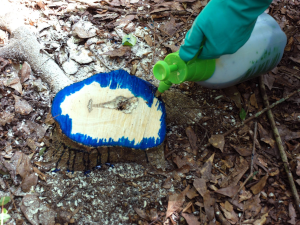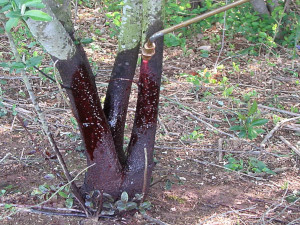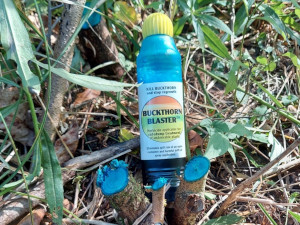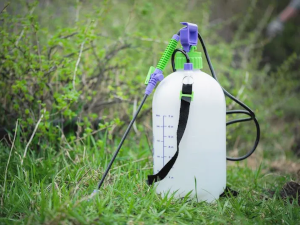Herbiciding
While the use of chemical herbicides get a bad wrap these days, the truth is - when used properly - herbicides are a critical part of any restoration effort. While short lived plants such as biennials can be effectively controlled by cutting and pulling, the same is not true for perennials, trees, shrubs and woody vines. Without the strategic application of herbicide, these plants will bounce back and resprout, requiring you to revisit the same plant again and again. You may be willing to do this in your garden, but for a large forest preserve it is an inefficient use of your time.
In order to prevent resprouting, a small amount of systemic herbicide is applied to the cut stem, which then moves throughout the root system and kills it. This cut stump treatment is the method used for trees, shrubs and vines, and can also be used for perennial plants that are interspaced with desirable species. Volunteers are trained and certified on the handling and use of two herbicides - glyphosate and garlon 4.

Cut Stump Treatment
Before herbiciding, all stumps should be cut horizontally and as close to the ground as possible. From a safety perspective, this reduces the risk of someone tripping over the stump and injuring themself; from a restoration point of view, it means there are fewer buds that can resprout from the stem, and the herbicide is applied much closer to the roots.
Both glyphosate (30%) and Garlon 4 (30%) can be used any time of the year except early spring; at this time, the upward flow of sap prevents the herbicide from reaching the roots. Late summer and fall are the best times to treat stumps as the tree is preparing for winter and the sap flow is reversed.
When applying herbicide to large stumps, you only need to treat the outer part of the trunk where the cambium is located. This is the living tissue that includes the phloem and xylem responsible for transporting nutrients and water respectively.
As glyphosate is water based, it must be applied to the stump as soon as possible in order to be absorbed (<30 mins), otherwise the plant will begin to seal the wound. If necessary, make a fresh cut. Garlon 4 is oil based, and so the active ingredient can penetrate through the stem, even if applied days after cutting.

Basal Bark
Basal bark treatment involves spraying herbicide around the base of a trunk, up to 12 - 18 inches in height. The herbicide will then penetrate into the trunk, where it will be transported throughout the tree, slowly bringing about its death. For this technique to work, you must first use an oil based herbicide, the outer bark must be thin enough to allow the herbicide to pass throug, and the tree is fully leafed out.
While this is not a technique I currently employ at Oakhurst, it is a way to kill trees less than 6in in diameter, including tree of heaven and black locust. As black locust is clonal, this method can help limit the stimulation of root suckers.
Applicators

Buckthorn Blaster
For the last few years, I have been using the buckthorn blaster for all cut-stump treatment. This is a small bottle with a cap that, when pressed down on the stump, opens a valve allowing the herbicide to flow. The tip is covered with an absorbent foam material, although this does not last very long. Rather than replacing the foam cap, I find it still works well enough. The big advantage of the buckthorn blaster is that you use far less herbicide with very little waste. The downside is that it requires a lot more bending or kneeling down.

Herbicide Applicator
I have several herbicide spray applicators, several two gallon and a single one gallon. I use the smaller applicator to store some 30% glyphosate, which I then use to fill the buckthorn blasters. The larger applicators are used in spring and summer to treat rosettes, reed canary grass, cattails and giant reed.

 Volunteering
Volunteering Safety
Safety Wildlife
Wildlife Newsletter
Newsletter